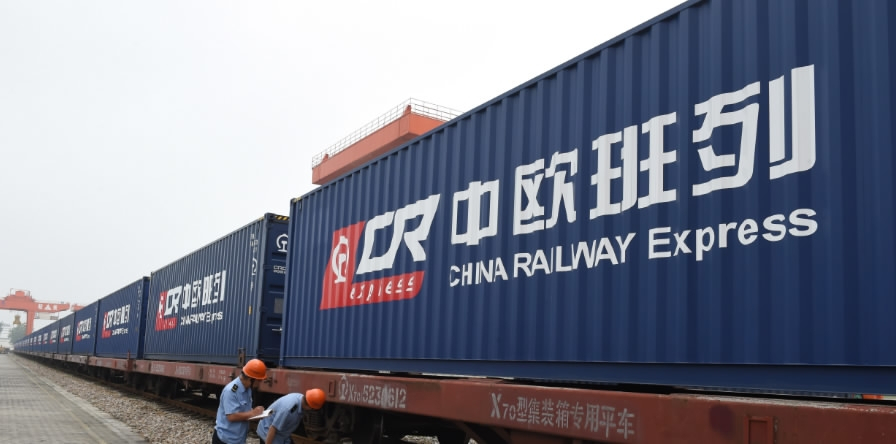
Alibaba Cloud logo is seen at 2019 Hangzhou Apsara Conference, September 25, 2019. /VCG
Alibaba Cloud logo is seen at 2019 Hangzhou Apsara Conference, September 25, 2019. /VCG
Editor's note: Pradumna B. Rana is a visiting associate professor at S. Rajaratnam School of International Studies (RSIS), Nanyang Technological University, Singapore. Ji Xianbai holds a doctorate from RSIS. They are coauthors of the forthcoming book entitled "China's Belt and Road Initiative: Impacts on Asia and Policy Agenda." A version of this article has appeared earlier as RSIS Commentary. The article reflects the authors' opinions, and not necessarily the views of CGTN.
In the shadow of COVID-19, the global economic outlook has become dismal. The International Monetary Fund (IMF) recently noted that the economic contraction this year will be so bad that only a handful of people in the world will have experienced a similar event in their adult lifetimes.
Against this backdrop, the physical infrastructure component of China's massive Belt and Road Initiative (BRI) – or "Physical BRI" – has slowed, for several reasons. First, with the ongoing public health crisis, BRI participating countries have put infrastructure development on the back burner.
Second, wholesale community lockdowns and factory closures have disrupted vital BRI supply chains including those supplying Chinese construction machinery and materials.
Third, Chinese migrant workers previously working on BRI projects have often been quarantined (as in Singapore), repatriated (as in Iran), or temporarily banned from entering the country (as in Indonesia) for public health reasons.
But the BRI is Chinese President Xi Jinping's signature foreign and economic policy initiative. China is, therefore, not abandoning it. In fact, China has adopted a two-stage approach in reviving the BRI practically.
First, with the slowing of the Physical BRI, China is focusing on the non-physical components of the BRI, namely the "Health Silk Road" (HSR) and the "Digital Silk Road" (DSR). In the COVID-19 period, HSR and DSR have become the brand names for BRI. Financing requirements for these two initiatives are also relatively less than for building large cross-border physical infrastructure.
The HSR is a term coined by President Xi during his visit to Geneva in January 2017 when he signed a memorandum of understanding with the World Health Organisation (WHO), committing that the HSR would seek to improve public health along the BRI countries.

The China-Europe container trains have become a driving force for the development of the Belt and Road Initiative. /Xinhua
The China-Europe container trains have become a driving force for the development of the Belt and Road Initiative. /Xinhua
In response to COVID-19, China has greatly accelerated activities to revive the HSR. Take, for example, the China-Europe Express Rail. At a time when travel bans choke much of the global air and sea transport, freight trains connecting China and Europe are ferrying medicines, equipment and anti-epidemic supplies to countries across Eurasia including notably Italy, providing a boost to their efforts to tame the disease.
Chinese companies implementing overseas BRI projects such as Huawei and Tencent have brought in relief packages from China, the world's biggest producer of medical kits, to fulfill their social responsibility to the locals. Chinese entrepreneurs are also on the frontline.
Jack Ma has donated 14 million U.S. dollars to international efforts to develop a coronavirus vaccine and sent personal protective equipment for distribution in Japan, the United States, and all 54 African nations.
Like the HSR, the DSR is also set to shine during the pandemic, for two reasons. Firstly, many countries have doubled down on various China-inspired digital solutions to combat COVID-19. China's use of a color-coded application for monitoring individuals' health, contacts and movement is a case in point. The app is being replicated by other affected countries. For example, in March, Singapore rolled out a similar app called "TraceTogether."
Secondly, COVID-19 is transforming economies, shifting the balance between electronic and retail commerce in favor of the former. With the COVID-19 outbreak and social distancing measures continually pushing economic activities online, China's DSR is set to rise in prominence.
Once supply chains reconnect and global health issues are resolved, China and BRI participating countries will once again re-start the Physical BRI to build transportation networks, industrial parks and power plants across the vast Afro-Eurasian supercontinent.
COVID-19 will thus have provided an opportunity for China to reflect on its BRI project of the past six years or so and contemplate ways to improve it.
At the Second Belt and Road Summit in 2019 President Xi had acknowledged various constructive criticisms and pledged to reform the BRI. Fine tuning and quality control were to be done with emphasis on "high quality" infrastructure projects. Green and clean cooperation was also pledged.
In this context, a number of studies have recommended policy agenda for both China and BRI participating countries to work towards an improved BRI. In our forthcoming coauthored book entitled China's Belt and Road Initiative: Impacts on Asia and Policy Agenda, we also make 10 key policy recommendations to enhance the prospect of a successful and mutually beneficial BRI 2.0 to both China and participating countries.
Summing up, in the two-stage approach that China has adopted to revive the BRI, it is presently focusing quite appropriately on the HSR and the DSR. In anticipation of the second stage, the revival of Physical BRI, it should also consider implementing the various reform proposals that have been advocated.
(If you want to contribute and have specific expertise, please contact us at opinions@cgtn.com.)